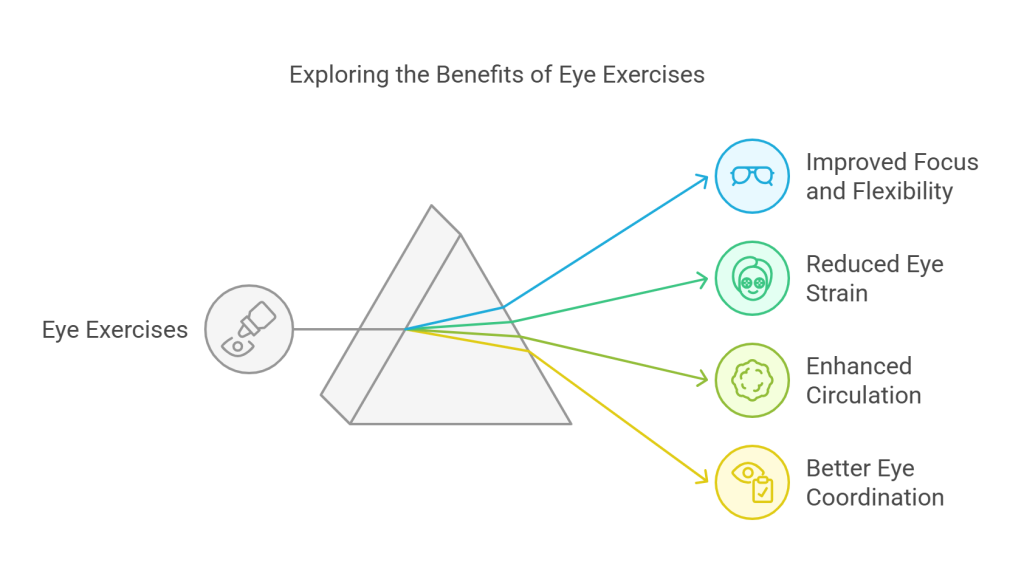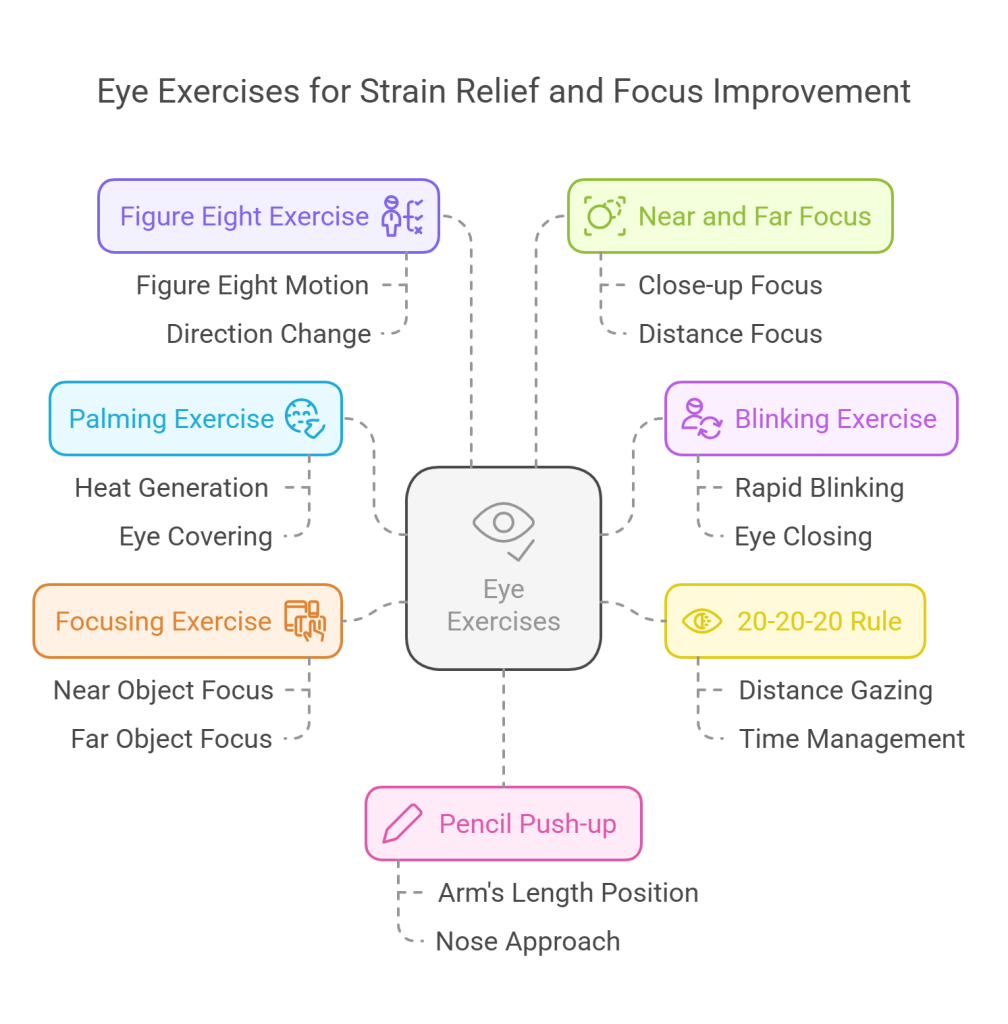|
Getting your Trinity Audio player ready...
|
Eye Exercises to Remove Glasses- For many people, glasses or contact lenses are an everyday part of life. Whether it’s for reading, driving, or just going about daily tasks, the need for corrective eyewear can become a constant inconvenience. The good news is that there are natural ways to reduce your dependence on glasses, and one of the most popular methods is through eye exercises to remove glasses.
In this blog, we’ll explore various eye exercises to reduce power, how they work, and which exercises might help improve your vision. While these exercises may not eliminate the need for glasses for everyone, they can be an excellent way to strengthen the eye muscles, reduce eye strain, and in some cases, improve your eyesight.
Let’s dive in!
What Are Eye Exercises?
Before we get into the specific exercises, it’s important to understand what eye exercises are. Eye exercises are activities designed to improve the focus, flexibility, and strength of the eye muscles. These exercises can be used to relieve eye strain, improve vision clarity, and reduce the need for corrective eyewear over time.
Some eye exercises are meant to improve the focusing power of the eyes, while others may help with conditions such as eye fatigue, dry eyes, and even certain refractive errors like myopia (nearsightedness) and hyperopia (farsightedness).
While eye exercises to remove glasses aren’t a substitute for professional eye care, they can be a useful addition to your vision health routine, especially for individuals who experience eye strain, digital eye fatigue, or want to reduce their dependence on glasses.
Eye Exercises to Reduce Power: How They Work

The idea behind exercises for eyes to remove glasses is that they help to strengthen the eye muscles and improve the focusing ability of the eyes. This is especially useful for people who have refractive errors like nearsightedness or farsightedness, which occur when the eye’s shape causes light to focus either in front of or behind the retina.
Regular eye exercises aim to improve the eye’s natural ability to focus, potentially reducing the need for corrective lenses over time. While these exercises cannot guarantee that you’ll completely eliminate glasses, they can help to alleviate some of the strain and discomfort associated with prolonged use.
Benefits of Eye Exercises for Vision
- Improved Focus and Flexibility: Regular practice can help your eyes focus better, which can reduce the need for glasses over time.
- Reduced Eye Strain: Many of us spend hours looking at screens, which can cause eye fatigue. Eye exercises help to relieve that strain.
- Enhanced Circulation: Certain exercises help stimulate blood flow to the eyes, which can improve overall eye health.
- Better Eye Coordination: Exercises can improve the coordination between both eyes, making it easier to focus on objects at different distances.
Now, let’s take a look at some of the exercises for eyes to remove glasses that you can try.
Top Eye Exercises to Remove Glasses

1. The Palming Exercise
This simple yet effective exercise helps to relax the eye muscles and reduce strain. It’s a great exercise for those who spend long hours in front of a computer or reading.
How to do it:
- Rub your palms together to generate heat.
- Close your eyes and gently cup your palms over your eyes without putting pressure on your eyeballs.
- Take slow, deep breaths while focusing on the warmth and darkness. Let the tension in your eyes dissolve for about 30 seconds to 1 minute.
- Repeat 3–4 times.
This exercise not only helps to relax the eyes but also improves blood flow to the eye area, giving them a much-needed rest.
2. Blinking Exercise
Blinking is a natural reflex that helps to keep your eyes moist and refreshed. However, when we focus on screens or tasks for long periods, we tend to blink less, which can lead to dry eyes and fatigue.
How to do it:
- Sit comfortably and take a few deep breaths.
- Blink your eyes rapidly 10–15 times.
- Close your eyes for a few seconds, then blink again.
- Repeat the process 5–10 times.
This exercise helps lubricate your eyes, reduce dryness, and improve focus. Blinking exercises can be especially helpful if you suffer from digital eye strain due to long hours of screen time.
3. The 20-20-20 Rule
One of the most effective ways to reduce eye strain is to give your eyes regular breaks. The 20-20-20 rule is a simple practice where you look at something 20 feet away every 20 minutes for 20 seconds.
How to do it:
- Every 20 minutes, take a break from your screen.
- Look at an object or scene that is about 20 feet away from you.
- Focus on it for 20 seconds to give your eyes a break and refocus.
- Repeat this process throughout your day.
This is a simple but highly effective way to reduce eye fatigue, especially for those working at a desk or using screens for extended periods.
4. Focusing Exercise
Focusing exercises help train the eyes to adjust quickly between different distances, which can be helpful for those who have trouble seeing objects up close or far away. It also helps to improve the flexibility of the eye muscles.
How to do it:
- Hold your finger or a small object about 6 inches away from your face.
- Focus on the object for 10 seconds, then slowly move your finger or object to arm’s length while continuing to focus on it.
- Hold the object at arm’s length for 10 seconds, and then bring it back to the original position.
- Repeat this exercise 10–15 times.
This exercise works by strengthening the eye muscles and improving the ability to shift focus between near and far objects, which can help with both nearsightedness and farsightedness.
5. The Figure Eight Exercise
The figure-eight exercise helps improve the eye’s range of motion and flexibility. It’s an excellent exercise for both reducing eye strain and improving focus.
How to do it:
- Sit comfortably and look at an object directly in front of you.
- Imagine a large number “8” lying on its side in front of you.
- Slowly trace the figure-eight shape with your eyes, moving your eyes in a smooth, controlled motion.
- Continue tracing the figure-eight for 1–2 minutes, then switch directions.
- Repeat 2–3 times.
This exercise is particularly effective for improving the coordination and movement of both eyes together, which can improve overall visual acuity.
6. Near and Far Focus
This exercise helps to train the eyes to quickly adjust between different focal points, which is useful for reducing the need for corrective lenses when switching between near and far distances.
How to do it:
- Hold a small object, like a pen, about 6 inches from your eyes.
- Focus on it for 10 seconds.
- Look at an object in the distance for 10 seconds, then return your focus to the pen.
- Repeat this process for 2–3 minutes.
This exercise is a great way to help the eyes adjust between close-up and distant objects, which is useful for individuals with presbyopia (age-related farsightedness) or other focusing issues.
7. The Pencil Push-up
The pencil push-up is a classic exercise to strengthen the eye muscles and improve convergence (the ability of both eyes to focus on a single point).
How to do it:
- Hold a pencil or pen at arm’s length in front of you.
- Slowly bring the pencil toward the tip of your nose, keeping your focus on the text or symbol on the pencil.
- Keep bringing the pencil closer to your nose until you can no longer focus on it.
- Return the pencil to arm’s length and repeat 10–15 times.
This exercise helps with focusing and can be especially helpful for those experiencing double vision or difficulty focusing on near objects.
Can Eye Exercises Completely Remove Glasses?
While eye exercises can help strengthen the eye muscles and improve focus, it’s important to have realistic expectations. For individuals with mild refractive errors, exercises might help reduce the need for glasses or improve visual comfort. However, for more significant vision problems, such as high myopia or hyperopia, eye exercises may not completely eliminate the need for glasses.
In some cases, laser eye surgery or other medical interventions may be required to achieve long-term vision correction. It’s always a good idea to consult with an eye care professional to determine the best course of action for your specific needs.
FAQs
1. Can eye exercises really remove glasses?
Eye exercises can help improve focus and reduce eye strain, but they typically won’t completely eliminate the need for glasses, especially for individuals with high refractive errors. They can, however, help improve overall eye health and may reduce the need for corrective eyewear in some cases.
2. How long does it take to see results from eye exercises?
The results from eye exercises vary depending on the individual and the type of exercise being done. Most people may start to notice improvements in a few weeks to a few months, but consistent practice is key for long-term benefits.
3. Are there any risks associated with eye exercises?
Eye exercises are generally safe, but if you have an underlying eye condition or experience significant discomfort, it’s important to consult with an eye care professional. Overexertion or improper technique could cause strain, so it’s important to perform exercises gently and regularly.
4. Can I stop wearing glasses after doing eye exercises?
For some individuals with mild refractive errors, eye exercises may reduce the need for glasses or contacts. However, for more severe vision issues, professional treatment like laser surgery may be required to completely eliminate the need for glasses.
5. How often should I do eye exercises?
For optimal results, eye exercises should be done daily. You can start with a few minutes each day and gradually increase the time as you become more comfortable with the exercises.
Conclusion
Eye exercises to remove glasses can be an effective way to reduce your dependence on corrective lenses and improve overall eye health. While these exercises won’t work for everyone, they are a natural and non-invasive way to strengthen your eye muscles, improve focus, and alleviate eye strain. By incorporating these simple exercises into your daily routine, you may start to see improvements in your vision over time.
If you’re considering eye exercises or have concerns about your vision, it’s always a good idea to consult with an eye care professional. For personalized advice and treatment options, visit Indira Gandhi Eye Hospital and take the first step toward healthier, clearer vision.












